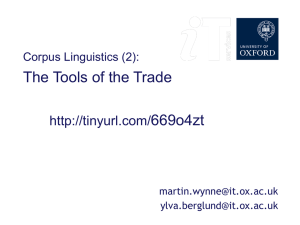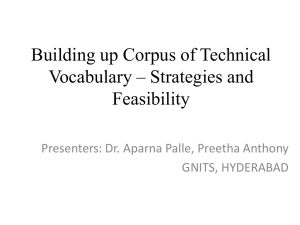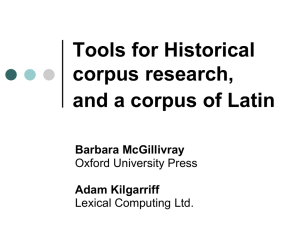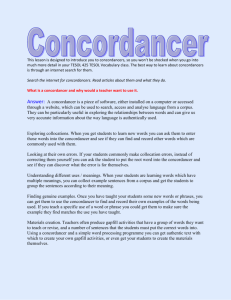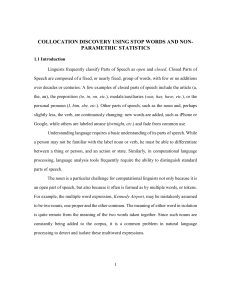See the PowerPoint Presentation
advertisement
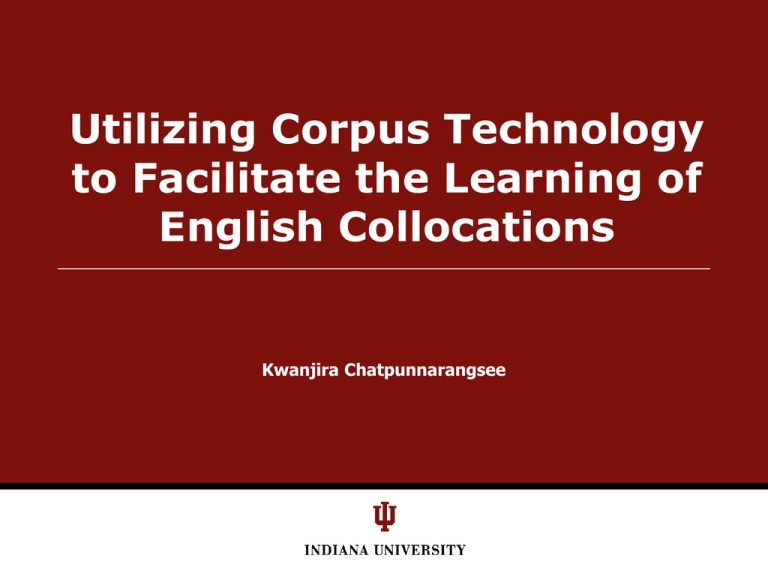
Utilizing Corpus Technology to Facilitate the Learning of English Collocations Kwanjira Chatpunnarangsee • Corpus/Corpora: A collection of written texts or transcriptions of spoken language stored electronically, and can be analyzed using a concordancer. • Collocation: A pair or group of words that are often used together e.g. fast car, fast food, a quick glance, a quick meal, make an effort, keep to/stick to the rules, etc. Types of collocation • • • • • • • Adjective + Noun (Unemployment is a major problem…) Noun+ Verb (The economy boomed in the 1990s.) Noun + Noun (Let's give him a round of applause.) Verb and Adverb (He pulled steadily on the rope and helped her to safety.) Adverb and Adjective (They are happily married.) Verb +Preposition (Your grade will depend on your work.) Adjective preposition (The little girl is afraid of the dark.) INTRODUCTION • English writing is considered to be a very important skill that could help ESL/EFL students either to have access to good jobs or to gain admission to higher education. • Students lack knowledge of common English expressions/ collocations and this development results in their writing English with a “foreign accent”. • It is important for English teachers to focus on instructional methods which can reduce the frequency of students using this “foreign accent,” as the benefit is twofold: – beginning students will be able to produce a piece of writing that proves more understandable, – more advanced students can be encouraged to achieve near-native writing fluency. • ESL/EFL students do not have sufficient linguistic input to help them acquire English collocations. • Corpus technology is believed to be able to provide this type of input. • Online concordancer LITERATURE REVIEW For: • Many studies (Chang & Sun, 2009; Sinclair, 1997; Sun, 2003; Varley, 2008; Yoon, 2008) suggest that corpus consultation may be useful for language learning because it can provide examples of real language as it is actually used, and this resource could be considered as invaluable input for acquisition to take place. Against: • Corpus data VS dictionaries. Some dictionaries also include collocations and examples of sentences being used in a word. • Language in a corpus is de-contextualized as it is often presented in a sentence-based (or even half sentence) form (Wu, 2009). • Students may find too many examples, which could have an effect on students’ comprehension to some extent. • Students may find too few examples, or none at all, if they conduct a search in a fairly small corpus or in a specialized corpus that does not include a particular word. Corpus-based Studies in the Thai Context • Todd (2001) examined students’ induction ability resulting from concordancing activity. • Sripicharn (2002) evaluated the use of teacher-designed DDL materials. CONCEPTUAL FRAMEWORK • Data-Driven Learning (DDL) approach claims that language learners can use data derived from electronic corpora as linguistic sources. DDL attempts to “cut out the middleman as far as possible and give direct access to the data so that the learner can take part in building up his or her own profiles of meanings and uses” (Johns, 1991b, pp. 30-31). • Three effects of adopting the DDL approach: – 1. DDL can affect the language learning process by helping the learner develop the ability to see patterns in the target language, and by extension, to form generalizations to account for that patterning; – 2. DDL also has an effect on the teacher’s role, in that the teacher becomes more like a director or coordinator of student research; and – 3. DDL makes possible a new style of grammatical consciousness-raising by placing the learner’s own discovery of grammar at the center of language learning. METHODOLOGY Research Questions • 1.How do the students describe their problem solving processes and strategies in the web-based concordancing setting? • 2.How do the students describe their views toward using corpus data as a linguistic reference? • Participants • Nada, 31, possessed an Engineering undergraduate degree from a Thai university, and had stayed in the U.S. for fifteen months, TOEFL score of 550. • Karn, 26, was a student in the Intensive English Program and had stayed in the U.S. for seven months,TOEFL score of 540. The Context • Workshop, met four times, two hours each • A textbook titled, Paragraph Writing: A Process Approach Chapters Titles Rhetorical foci 1 Memories Narrating past events 2 People Around Us Describing a person 3 A Special Place Describing a place 4 Celebrations Describing present events 5 Leisure Time Giving details and examples 6 Education and Student Life Giving reasons to support opinions Each chapter was organized to follow eight steps in the writing process: generating ideas, organizing ideas, development cohesion, writing the first draft, revising your writing, editing your writing, writing the second draft, and developing your skills. Instruments and Data Sources • • • • • • • Concordancer and corpora Narrative description of think-alouds Interviews and transcriptions Pre and post-project questionnaires Pre-test and post-test Written reflections Collocation worksheets Think-aloud task • • • • • • • • • • • The task was based on the following ten collocations, adapted from the British National Corpus (Written and Spoken) and the Brown Corpus on Lextutor website. Those collocations were (1) in his late teens, (2) of medium height, (3) ashamed of, (4) on the phone, (5) between 10 p.m. and 2 a.m, (6) get so annoyed, (7) turn grey, (8) immediate reaction, (9) came running, and (10) one of the events. Then, eight out of ten collocations were replaced by the following incorrect collocations. I met someone who was *about his late teens. He is *a medium height. He is now *ashamed from his conduct. He talks *on a phone. He talks *between 10 p.m. to 2 a.m. I get so annoyed with his talking and laughing. Some days I think my hair could *get grey because of my roommate’s behavior. My roommate always has *immediately reaction to the expressions. He came running to pick me up. It was *one of events that showed me how thoughtful he is. FINDINGS Students’ problem solving processes and strategies in a web-based concordancing setting • The participant guessed the correct answer whenever they could and then used the concordancer to confirm or disconfirm their initial assumption. An example of when concordance lines disconfirmed their guess. Item 5, He talks *between 10 p.m. to 2 a.m. Nada: “I have always thought between (time) to (time) was correct because this phrase can be written with a dash and a dash to me means to. I am surprised. Now I am looking at other examples. I can see that between ...and … can be used with many different things such as age (between 2 and 5 years old), distance (between 200 and 400 meters), percent (between 11 and 17 percent).” • They used their English grammatical knowledge to help them derive at a correct answer. • However, heavy reliance on grammatical knowledge (Karn’s case) seemed to hinder him from paying attention to the context of the question and the examples on the output page, and misled him to give a wrong answer. – Item 7 Some days I think my hair could *get grey because of my roommate’s behavior. Paying attention to the context in which the collocations were in was important. Nada’s case item 2 He is *a medium height. She found 118 concordance lines. She looked at the ones that were relevant to her query, as shown in the figure, and she clicked on KWIC (Key Word In Context), HEIGHT on line 55 to see its full text. She decided that of medium height was the correct answer because it can be used to describe a person’s appearance, and her item 2 seemed to have the same purpose. • Problems that the participants encountered: • 1.Sometimes too many results on the output page, other times, too few results; • 2.The issue of choosing a keyword. If they picked the wrong keyword, they did not receive the right set of data; • 3.The problem of choosing a corpus. Students’ views toward using corpus data as a linguistic reference • The perceived advantages of concordancing • 1.They could take a more active role in learning; • 2.They could be more autonomous learners; • 3. They remembered the new knowledge better. • Perceived disadvantages of concordancing • 1. The complex process involved in using the tool (It took time and effort to get to the data and to derive correct collocations from corpus data, due to the difficulty level of the examples and the availability of data in the corpora); • 2. The appearance of the tool is not interesting. The results of the post-project questionnaires corresponded to the interview responses in many ways. Benefits of corpus use Problems or difficulties of corpus use Overall evaluation of corpus use CONCLUSION & RECOMMENDATIONS • The results of this study suggest that whether learners can successfully take part in building up their own profiles of meanings and uses partly depends upon their English proficiency level. The student with a high English proficiency demonstrated a strong capability in analyzing corpus data and using inductive abilities to solve collocation problems; however, this was not always the case for the lower proficiency student. Yet, access to linguistic data with established software proved to offer invaluable input; therefore, for pedagogical recommendations, some assistance such as scaffolding activities or step-by-step instructions of how to analyze corpus data could be useful from the outset, so as to guide learners to experience successful collocation learning. Limitations • 1. The types of collocation that should have been included were noun+verb, noun+noun. • 2.Items for the think-aloud task should have included an item where participants were required to come up with a new keyword, such as the one in item 7 *get grey. These types of prompts could distinguish the difference between high and low proficiency students’ problem-solving processes. • 3.It would have been useful to keep track of time for each concordance session, to examine whether the participants took less time as they worked on latter concordance task. • **Future studies in the same vein should consider addressing these limitations.** References • • • • • • • • Chalermpatarakul, C. (2006). Paragraph writing: A process approach. Bangkok: Thammasat University Press. Chang, W. & Sun, Y. (2009). Scaffolding and web concordancers as support for language learning. Computer Assisted Language Learning, 22(4), 283-302. Johns, T. (1991a). Form printout to handout: Grammar and vocabulary teaching in the context of data-driven learning. In T. Johns & P. King (Eds.), Classroom Concordancing, ELR Journal, 4 (pp.27-45). Birmingham: University of Birmingham. Johns. T. (1991b). Should you be persuaded: Two samples of data-driven learning. English Language Research Journal,4, 1-46. Marriam, S. (2002). Qualitative Research in Practice. San Francisco, CA: Jossey-Bass. Partington, A. (1998). Patterns and meaning: Using corpora for English language research and teachin. Amsterdam: Johns Benjamins. Rutherford, W. (1987). Second Language Grammar: Learning and Teaching. London:Longman. Sinclair, J. S. (1997). Corpus evidence in language description. In A. Wichmann, S. Fligelstone, T. McEnery & J. Knowles (Eds.), Teaching and language corpora (pp. 2739). London: Longman. • • • • • • • • • Sripicharn, P. (2002). Evaluating data-driven learning: the use of classroom concordancing by Thai learners of English. Unpublished PhD dissertation, The University of Birmingham. Sun, Y. (2003). Learning process, strategies, and web-based concordancers: A case study. British Journal of Educational Technology, 34(5), 601-613. Todd, R. (2001). Induction from self-selected concordances and selfcorrection. System, 29, 91-102. Varley, S. (2008). I’ll just look that up in the concordance: Integrating corpus consultation into the language learning environment. Computer Assisted Language Learning, 22(2), 133-152. Woolard, G. (2000). Collocation - encouraging learner independence. In M. Luwis (Ed.), Teaching collocation: Future Development in the Lexical Approach (pp. 28-46). Hove: Language Teaching Publications. Wu, W. (2009). The marriage between corpus-based linguistics and lexico-grammar instruction: Using advise, recommend, and suggest as an example. Retrieved on November 3, 2009 from http://www.j-let.org/~wcf/proceedings/d072.pdf Yoon, H. (2008). More than a linguistic reference: The influence of corpus technology on L2 academic writing. Language Learning and Technology, 12(2), 31-48. Yoon, H. & Alan, H. (2004). ESL student attitudes toward corpus use in L2 writing. Journal of Second Language Writing, 13, 257-283.



